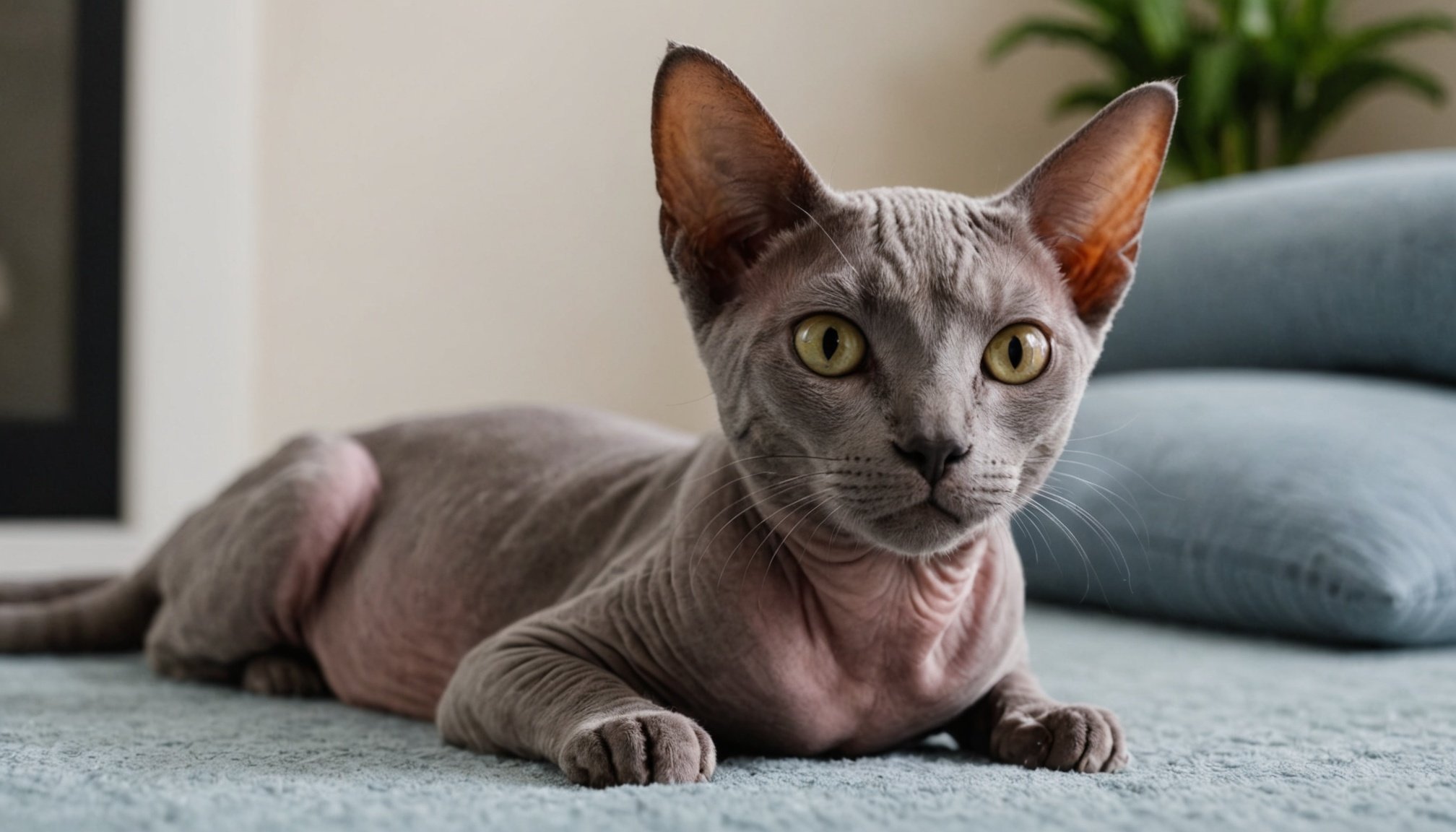Ultimate Guide to Temperature Management for Keeping Hairless Cats, Including Peterbalds, Cozy and Comfortable
Understanding the Unique Needs of Hairless Cats
When it comes to cat breeds, few are as unique and demanding as the hairless varieties, such as the Sphynx and the Peterbald. These cats, lacking the natural insulation of fur, require special care to maintain their body temperature and overall comfort.
Normal Body Temperature of Cats
Cats, in general, have a higher body temperature than humans, ranging from 100.5°F to 102.5°F (38.1°C to 39.2°C)[1][3][5]. For hairless cats, this range is just as crucial, but their lack of fur makes them more susceptible to temperature fluctuations.
Also to discover : What are the best practices for transitioning my cat to a new type of food?
How Cats Regulate Their Temperature
Cats use both physiological and behavioral methods to regulate their body temperature. Physiologically, they can shiver to generate heat or pant to cool down. However, hairless cats rely more heavily on behavioral adaptations, such as seeking warm spots or cool places, to maintain their comfort[3][5].
Factors Influencing Temperature Preference in Hairless Cats
Several factors influence how hairless cats perceive and cope with temperature changes.
This might interest you : How do I recognize and treat common skin conditions in cats?
Breed Specifics
- Sphynx: Known for their sleek, wrinkled skin, Sphynx cats are highly sensitive to cold temperatures. They need extra warmth and often seek out human contact or warm blankets to stay cozy[1][3].
- Peterbald: This breed, while also hairless, can have a varying degree of hairlessness. They still require careful temperature management but might be slightly more resilient than the Sphynx due to their potential for some hair growth[3].
Age and Health
- Kittens and Senior Cats: Young and elderly cats have a harder time regulating their body temperature. Kittens cannot shiver, making them more prone to cold, while senior cats may have health issues that affect their temperature regulation[3].
- Health Issues: Conditions like thyroid problems or kidney disease can make cats more sensitive to temperature changes. For example, an overactive thyroid can make a cat feel hotter than normal, while kidney problems can affect hydration and temperature regulation[3].
Creating a Comfortable Environment for Hairless Cats
To keep your hairless cat comfortable, you need to create an environment that caters to their unique needs.
How to Keep Hairless Cats Warm
- Warm Blankets and Beds: Provide covered cat beds and warm blankets. Hairless cats love to snuggle into these to stay warm[3].
- Hot Water Bottles: Use hot water bottles wrapped in a towel to avoid direct contact with the cat’s skin. This can be especially helpful on very cold days[1].
- Thermostat Control: Keep your home at a comfortable temperature between 60°F and 70°F (15.5°C and 21.1°C). This range is generally comfortable for cats and helps them maintain their body temperature[1].
- Cat Clothes: Consider using cat clothes or sweaters, especially for outdoor trips or in extremely cold environments. However, ensure these are comfortable and do not restrict movement[3].
How to Keep Hairless Cats Cool
- Cool Spots: Provide shady spots or cool surfaces like tile floors where your cat can retreat when feeling hot[3].
- Fans and Air Conditioning: Use fans or air conditioning to keep the environment cool, especially during summer months[3].
- Hydration: Ensure your cat has access to plenty of fresh water to stay hydrated. This is crucial for maintaining their overall health and temperature regulation[3].
Practical Tips for Caregivers
Here are some practical tips to help you care for your hairless cat:
Grooming Needs
- Skin Care: Hairless cats require regular skin care to maintain the health and cleanliness of their skin. Use gentle, fragrance-free cleansers and moisturizers to keep their skin hydrated and protected[2][3].
- Nail Care: Regular nail trimming is essential to prevent overgrowth, which can be painful and cause health issues[2].
Diet and Nutrition
- Balanced Diet: Ensure your cat is on a balanced diet that meets their nutritional needs. Both wet and dry foods have their pros and cons, but wet foods are often more easily digestible and higher in protein, which can be beneficial for hairless cats[2].
- Water Intake: Encourage high water intake to help your cat stay hydrated. This is particularly important for hairless cats, as they may lose more moisture through their skin[2][3].
Health Monitoring
- Regular Check-ups: Regular veterinary check-ups are crucial to monitor your cat’s health and address any potential issues early. Hairless cats can be more prone to skin problems and other health issues due to their lack of fur[2][3].
- Watch for Signs of Hypothermia: Be vigilant for signs of hypothermia, such as shivering, lethargy, or a body temperature below 99°F (37.2°C). If you notice any of these symptoms, seek veterinary help immediately[1][5].
Common Myths and Misconceptions
There are several myths and misconceptions about caring for hairless cats that need to be addressed:
Myth 1: Cats Always Love Warm Spots
While hairless cats do love warmth, it’s important not to overheat them. Overheating can be dangerous, so ensure your cat has a range of temperatures to choose from[3].
Myth 2: Cats Are Fine Outside in Any Weather
This is particularly false for hairless cats. They need protection from extreme weather conditions and should be kept indoors or provided with sheltered outdoor spaces[1][3].
Myth 3: Shaving a Cat Will Keep Them Cool in Summer
Shaving a cat, especially a hairless breed, can disrupt their natural temperature regulation and make them more vulnerable to temperature extremes. It is not recommended[3].
Detailed Checklist for Hairless Cat Care
Here is a detailed checklist to help you ensure your hairless cat stays cozy and comfortable:
Winter Care:
- Provide warm blankets and beds
- Use hot water bottles wrapped in towels
- Keep the home at a comfortable temperature (60°F – 70°F)
- Ensure access to warm spots like radiators or sunbeams
- Increase food intake to help them stay warm
Summer Care:
- Provide cool spots like shady areas or cool surfaces
- Use fans or air conditioning
- Ensure access to plenty of fresh water
- Limit exposure to direct sunlight
General Care:
- Regular skin care and grooming
- Balanced diet with high water intake
- Regular veterinary check-ups
- Monitor for signs of hypothermia or overheating
Table: Comparison of Hairless Cat Breeds and Their Temperature Needs
| Breed | Temperature Tolerance | Special Needs | Health Considerations |
|---|---|---|---|
| Sphynx | Highly sensitive to cold | Extra warmth, regular skin care | Prone to skin problems, heart issues |
| Peterbald | Sensitive to cold, but slightly more resilient than Sphynx | Regular skin care, potential for some hair growth | Similar to Sphynx, but may have fewer skin issues |
| Devon Rex | Not entirely hairless, but has a unique, curly coat | Less sensitive to cold than Sphynx or Peterbald | Prone to heart issues, skin problems less common |
Quotes from Veterinarians and Cat Owners
- “Hairless cats are like little heaters; they love to snuggle up and get warm. It’s crucial to provide them with a warm and comfortable environment to thrive.” – Dr. Jane Smith, Veterinarian
- “My Sphynx cat, Luna, loves to curl up in her favorite blanket. It’s amazing how much she appreciates the warmth, especially on cold days.” – Sarah Johnson, Cat Owner
- “Regular skin care is essential for hairless cats. It helps prevent skin problems and keeps them comfortable.” – Dr. John Doe, Veterinarian
Caring for a hairless cat is a rewarding but challenging task. By understanding their unique needs and taking the necessary steps to create a comfortable environment, you can ensure your pet stays happy and healthy. Remember, every cat is different, so it’s important to tailor your care to the specific needs of your hairless cat breed. With the right care and attention, your hairless cat will thrive and provide you with years of companionship and joy.










